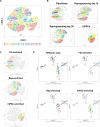Mass cytometry-based single-cell analysis of human stem cell reprogramming uncovers differential regulation of specific pluripotency markers
- PMID: 31570522
- PMCID: PMC6901311
- DOI: 10.1074/jbc.RA119.009061
Mass cytometry-based single-cell analysis of human stem cell reprogramming uncovers differential regulation of specific pluripotency markers
Abstract
Human induced pluripotent stem cells (hiPSCs) are reprogrammed from somatic cells and are regarded as promising sources for regenerative medicine and disease research. Recently, techniques for analyses of individual cells, such as single-cell RNA-Seq and mass cytometry, have been used to understand the stem cell reprogramming process in the mouse. However, the reprogramming process in hiPSCs remains poorly understood. Here we used mass cytometry to analyze the expression of pluripotency and cell cycle markers in the reprogramming of human stem cells. We confirmed that, during reprogramming, the main cell population was shifted to an intermediate population consisting of neither fibroblasts nor hiPSCs. Detailed population analyses using computational approaches, including dimensional reduction by spanning-tree progression analysis of density-normalized events, PhenoGraph, and diffusion mapping, revealed several distinct cell clusters representing the cells along the reprogramming route. Interestingly, correlation analysis of various markers in hiPSCs revealed that the pluripotency marker TRA-1-60 behaves in a pattern that is different from other pluripotency markers. Furthermore, we found that the expression pattern of another pluripotency marker, octamer-binding protein 4 (OCT4), was distinctive in the pHistone-H3high population (M phase) of the cell cycle. To the best of our knowledge, this is the first mass cytometry-based investigation of human reprogramming and pluripotency. Our analysis elucidates several aspects of hiPSC reprogramming, including several intermediate cell clusters active during the process of reprogramming and distinctive marker expression patterns in hiPSCs.
Keywords: OCT4; TRA-1–60; cell cycle; computational biology; iPS cell; iPSC; induced pluripotent stem cell; mass cytometry; pluripotency; reprogramming; single-cell analysis; spanning-tree progression analysis of density-normalized events (SPADE).
© 2019 Im et al.
Conflict of interest statement
The authors declare that they have no conflicts of interest with the contents of this article
Figures




Comment in
-
Specificity of anti-MYC antibodies.J Biol Chem. 2020 Jan 10;295(2):298. doi: 10.1074/jbc.L119.011910. J Biol Chem. 2020. PMID: 31924671 Free PMC article. No abstract available.
-
Reply to Cattoretti: Specificity of anti-MYC antibodies.J Biol Chem. 2020 Jan 10;295(2):299-300. doi: 10.1074/jbc.RL119.011997. J Biol Chem. 2020. PMID: 31924672 Free PMC article. No abstract available.
References
-
- Yu J., Vodyanik M. A., Smuga-Otto K., Antosiewicz-Bourget J., Frane J. L., Tian S., Nie J., Jonsdottir G. A., Ruotti V., Stewart R., Slukvin I. I., and Thomson J. A. (2007) Induced pluripotent stem cell lines derived from human somatic cells. Science 318, 1917–1920 10.1126/science.1151526 - DOI - PubMed
Publication types
MeSH terms
Substances
Grants and funding
LinkOut - more resources
Full Text Sources
Research Materials

